-
Sikhism 1469

Siri Guru Granth Sahib - The Abode of Nanak
The Siri Guru Granth Sahib is the embodiment of the spiritual revolution which was first ignited by Guru Nanak dev ji and the life breath of eight more Nanaks nurtured and fed this flame. Then in 1699 Guru Gobind Singh ji, the tenth Sikh Guru, transformed that flame into a wildfire of spiritual liberation through the creation of the Khalsa panth.
We look to Siri Guru Granth Sahib as our guide to connect with the One internally, see the One in all and fight inequality and injustice in every sphere of our lives as the Gurus themselves did. The image of Harimandir Sahib (Golden Temple) reflects the other half of the spiritual revolution because it represents the innumerable gurudwaras and abodes of Nanak which we create to enable the sadh sangat to come together, remember Guru Nanak’s message and carry on his revolution.
-
Battle of Chumkaur 1705
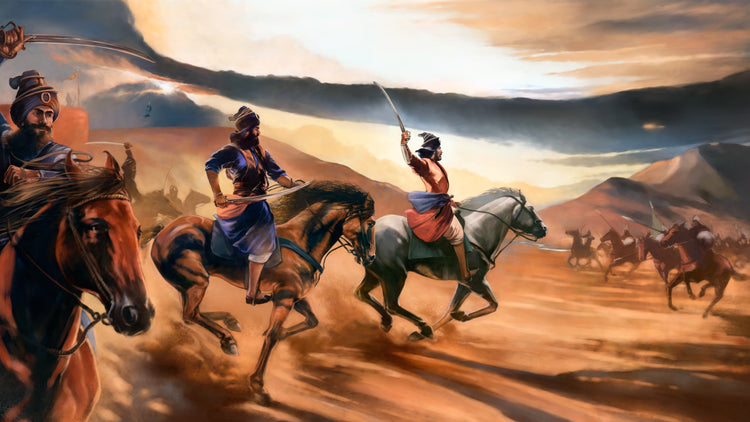
Baba Ajit Singh – The Khalsa Charge
In the prolonged siege of Anandpur in 1705, Sahibzada Ajit Singh displayed his qualities of courage and steadfastness. An unequal but grim battle commenced on 7 December 1704 in the words of Guru Gobind Singh's Zafarnama, a mere forty defying a hundred thousand. The besieged, after they had exhausted the meagre stock of ammunition and arrows, made sallies in batches of five each to engage the encircling host with sword and spear. Sahibzada Ajit Singh led one of the sallies and laid down his life fighting in the thick of the battle. He was 18 years old at the time of his supreme sacrifice for his faith. -
Battle of Chumkaur 1705

Baba Jujhar Singh
At the Battle of Chumkaur, Baba Jujhur Singh watched his brother Baba Ajit Singh attain Shaheedi. He desired to fight in the battlefield as well, though doing so meant certain death. He asked his father, Guru Gobind Singh, "Guru Sahib, permit me, dear father, to go where my brother has gone. Don't say that I am too young. I am your son. I am a Singh, a Lion, of yours. I shall prove worthy of you. I shall die fighting, with my face towards the enemy, with the Naam on my lips and the Guru in my heart." -
1705

Chhotey Sahibzadey
Zorawar Singh and Fateh Singh were the youngest of Guru Gobind Singh's sons, aged only 7 and 5 when they and their grandmother Mata Gujri were imprisoned by the tyrant Wazir Khan in Sirhind. Wazir Khab offered them safety if they converted to Islam or death if they refused. Though they were only young children physically, their spirit had been prepared for this moment since birth. The painting conveys their internal strength, honed as sons of Guru Gobind Singh and grandsons to Guru Tegh Bahadur, who also attained saheedi for refusing to give up the Sikh faith. Even though they are the ones being confined to darkness, they alone are the source of all radiance and light. That's why the painting shows the outside world painted in dark blood red like an open wound. The high walls of the fortress also question who is really imprisoned and who is really free. This painting Chhotey Sahibzadey reflects on their pure spirit which is prepared to embrace death and fears no one. -
Vaisakhi 1699

Mata Sahib Kaur - Mother of the Khalsa
Just as Guru Gobind Singh Sahib is considered the father of the Sikh nation, Mata Sahib Devan Kaur is considered its mother. A remarkable young woman, Mata Sahib Kaur was a born leader who took her role as symbolic mother of the Sikhs very seriously. When a Sikh takes Amrit from the 5 Beloved, they are born into the royal house of Nanak. To create an egalitarian society, all Sikhs consider Anandpur Sahib their birthplace and Mata Sahib Kaur their mother. -
Battle of Muktsar 1705
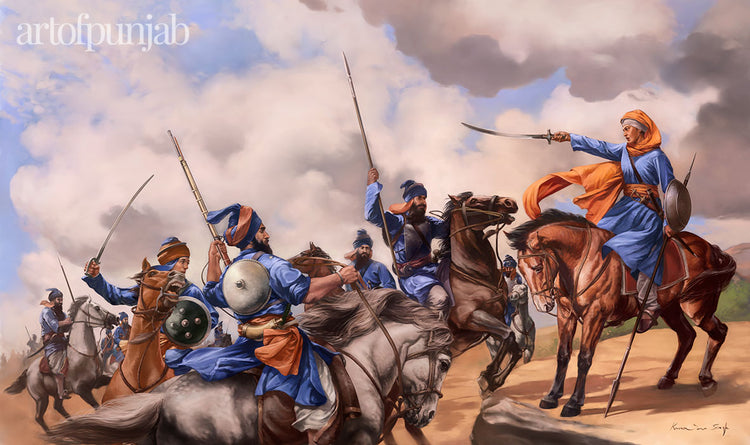
Mai Bhago and the Chaali Muktey
Mai Bhag Kaur (Mai Bhago) was the inspiration behind the bravery of the martyrs known as the Chaali Muktey (the Liberated Forty) who died in the 1705 Battle of Muktsar. When the siege went on for months, in hunger and despair, 40 Sikhs from Mai Bhago’s village of Jhabal lost heart and renounced their loyalty to the Guru in writing and deserted him. News of the betrayal quickly reached Jhabal and the ears of Mai Bhago. Boiling with rage, she went around the village and exhorted the women folk not to receive the deserters into their homes unless the made amends for the disgrace they had brought home with them. Mai Bhago rode out and intercepted the forty deserters as they neared the boundaries of the village. She challenged them to return to the service of the Guru and brought these men back to the path of devotion and sacrifice. -
1753

Baba Deep Singh Shaheed
1682-1753 Baba Deep drew a line with his Khanda and beseeched only those committed to giving their lives in defense of the Sikh faith to step over it. Five thousand Sikhs accompanied him on his journey to free Harimandir Sahib from the Afgan army that had desecrated it. Dressed as bridegrooms in fine clothing and festive ribbons, they joyously readied themselves to wed death. The painting speaks of this blessed journey and the mortal release experienced through their shaheedi spirit, where the spiritual fire upon which they cast their bodies also freed their souls. -
Battle of Anandpur 1700
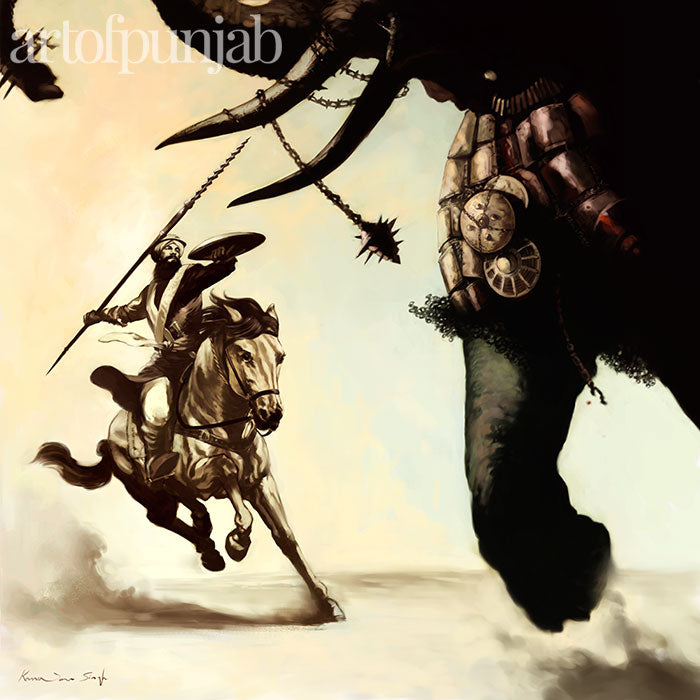
Bhai Bachittar Singh (Tonal) - Square
Initiated into the Khalsa on the historic first Vaisakhi Day, Bachittar Singh fought alongside Guru Gobind Singh in a number of battles in defense of Anandpur. This scene shows him in the famous single-handed combat with the enraged elephant charging at the Sikh fort of Lohgarh by the joint enemy forces of the Mughal Emperor Aurangzeb and the Hindu Hill Rajas. -
Battle of Anandpur 1700

Bachittar Singh – Saint Soldier
Initiated into the Khalsa on the historic first Vaisakhi Day, Bachittar Singh fought alongside Guru Gobind Singh in a number of battles in defense of Anandpur. This scene shows him in the famous single-handed combat with the enraged elephant charging at the Sikh fort of Lohgarh by the joint enemy forces of the Mughal Emperor Aurangzeb and the Hindu Hill Rajas. The Guru gifted Bhai Bachittar with two essential things to defeat the enraged beast, the Nagni spear and the courage to use it. -
1715

Banda Singh Bahadur - Sava Lakh Khalsa
Banda Singh Bahadur was handed the mantle of leadership from Guru Gobind Singh Ji himself. Born into the Hindu faith as Lachhman Dev, he encountered the Guru at Nander and immediately declared, “I am your Banda (slave).” Thus the Guru gave him the name Banda Singh Bahadur upon his initiation into the order of the Khalsa. After receiving the Guru’s blessing, Banda Bahadur became the first general of the Sikh panth. He amassed a force large enough to threaten the Mughal Empire and change the social, political and religious landscape of Punjab.“I will tell you, whenever men become so corrupt and wicked as to relinquish the path of equity and to abandon themselves to all kinds of excesses, then the Providence never fails to raise up a scourge like me to chastise a race so depraved; When the tyrants oppress their subjects to the limit, then God sends men like me on this earth to mete out his punishment to them.” – Banda Singh Bahadur
-

Pillar of Peace
The Harimandir Sahib is the heart of the Sikh Panth. It was conceived by Guru Ram Das ji when he built the sarovar on the site of a holy pool of water in the city of Amritsar, which he also founded. The next master, Guru Arjun completed the Harimandir sahib and installed the Adi Granth, the primal Sikh scriptures, within its walls. Harimandir sahib, in the time of the Gurus was not yet covered in gold but was already revered as the centre of Sikh spiritual life and the seat of the Gurus. Guru Hargobind would have looked across at its’ wondrous forms as he built the Akal Takhat to give Sikhs a place to settle all political and temporal affairs. Later Guru Teg Bahadur ji would sit upon the opposite edge of the sarovar and looked upon its’ four entrances with a pilgrim‘s longing when he was denied entry by the disloyal mahants. Nonetheless, the Sikh sangat of Amritsar still embraced their Guru within its’ view and today a small shrine marks that place on the sarovar in remembrance of their faith. Harimandir sahib has and will forever remain a vision of sanctity and peace within the hearts of every Sikh who lays eyes upon it. -
18th century Punjab

Sarbat Khalsa
During the turbulent 18th century, with the gradual collapse of the Mughal Empire and constant incursions by Afghan invaders into India, Sikhs became the de facto defenders of Punjab. During this period, Sikhs would congregate twice a year on Vaisakhi and Diwali at the Harminder Sahib. There, they would make important military and leadership decisions to help the Panth survive these difficult times. This system of collective governance allowed Sikhs to survive the tumultuous 18th century which included the greater and lesser Gulugara (Sikh Holocausts). This consensus based approach to leadership lasted throughout the Sikh Misl period and allowed them to become a collective force and the unquestioned rulers of the Punjab. The Sikhs served as the leaders and protectors of the region and through their courage and consciousness were able to lead the people through the extreme challenges of that time. -
1609 - present

Sri Akal Takhat Sahib – Throne of the Almighty
This painting illustrates what Sri Akal Takhat sahib, the central legacy of Guru Hargobind sahib our sixth Guru, means to the Sikh quam. The artwork weaves the stories and imagery we relate to Guru Hargobind sahib, such as Bandhi Chhor and Miri Piri (spiritual and temporal balance) to capture the essential nature of our eternal bond to the Akal Takhat as central institution of Sikhism. In this painting, the visualization of blood transforming into flower petals is a reminder that liberation can be found through sacrifice, when the cause is just. Countless shaheeds throughout our history teach us, that with the grace of the Guru and the willingness to bow ones heads in sacrifice, a transformation in the very depths of our being can be experienced. This perfect union of Miri Piri, the inseparable connection between Sri Harimandir Sahib and Sri Akal Takhat sahib is shown in the painting as two interwoven energies. Within their merger we see the khanda and the bata which represents the formation of the Khalsa panth and creation of a new type of being, the saint soldier. -
Timeless Warrior

Akali Nihang
The order of the Nihangs, a fiercely independent vangaurd of the Khalsa army is said to date back to the time of Guru Arjun and the formation of the Akal Sena. The Nihangs were fierce warriors who fought with little regard for life and limb. They are credited for being in the forefront of many of Maharaja Ranjit Singh's crucial campaigns such as the battles of Kasur, Multan and Naushera at which they took great losses in the service of the Sikh empire. Akali Phula Singh, amongst the most famed of all Akali Nihang leaders, died whilst leading a charge against the Ghazis at Naushera in 1823. A memorial to his courage still stands across the river in Kabul. -
1995

Jaswant Singh Khalra – The Witness
This painting chronicles the life's work of human rights activist Shaheed Jaswant Singh Khalra and the events of the bloody decade (1984 -1995) in Punjab. It depicts how government forces operated with complete impunity to end the Khalistan movement, and in doing so, carried out the secret murders of thousands of its' own citizens, many of them complete innocents. This portrait of Jaswant Singh Khalra and the state of Punjab speaks to the loss of humanity when power is asserted through terror and violence. In those desperate times, the Guru inspires great souls who act as our protectors, saving us from being engulfed by total darkness. In an inspirational speech, which was to be his last, Jaswant Singh Khalra declared: I challenge the darkness, if nothing else, then at least around myself, I will not let it settle. Around myself I will establish light."
Jaswant Singh Khalra was murdered at the age of 42, giving his life to the preservation of human rights in Punjab. To commemorate the incredible impact of his life, 42 rare Artist signed canvas prints will be released. All proceeds will go to Ensaaf, a charity dedicated to carrying forward his mission to end impunity and give voice to the disappeared. -
Timeless Warrior
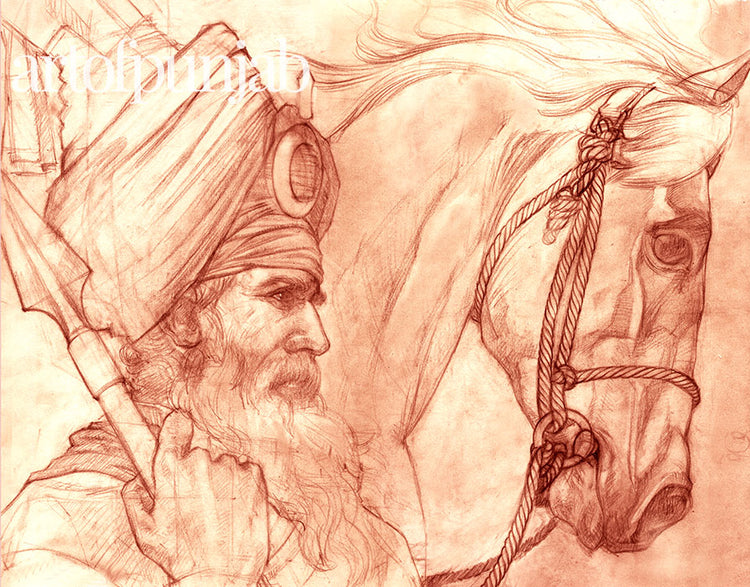
Akali (red chalk sketch)
The term Akali is derived from the gurbani term Akaal Pururk “The Timeless One”, a term for God, thus an akali is the “Servitor of the Timeless God.” This also reflects the idea of Akalis as the “Immortals” or the timeless warriors. Early Sikh military history is dominated by the Akali Sikh military order particularly for many famous military victories won while often heavily out-numbered. The Akalis have historically been held in great affection and respect by Sikhs due the pivotal role they have played in Sikh history and Sikh military history in particular. The Nihang order is today mostly ceremonial because it is peacetime in India but in times of war, the Akalis have historically spear-headed the attack on the enemies of the Sikh religion. -
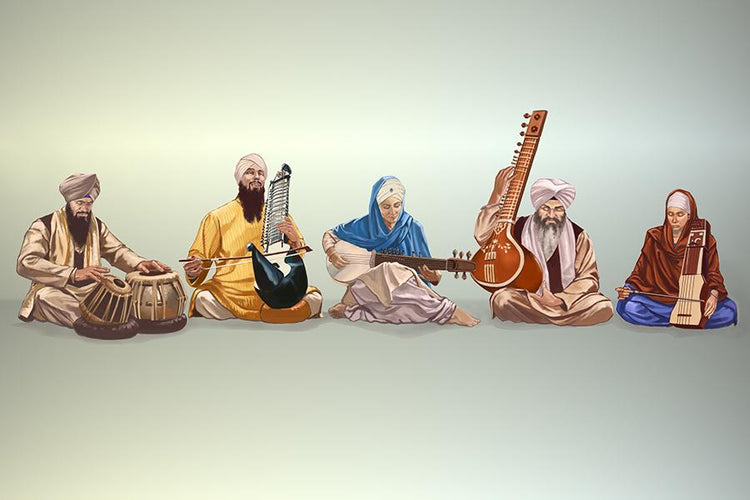
Kirtani Jatha
Kirtan is the devotional singing of praise as expressed in the hymns and compositions of Sikh scripture. Adoration expressed in song is considered by Sikhs to be the highest form of devotion, unsurpassed as the way to overcome the effect of ego and escape mortality. -
Battle of Anandpur 1700

Bhai Bachittar Singh (Tonal) - Wide
Initiated into the Khalsa on the historic first Vaisakhi Day, Bachittar Singh fought alongside Guru Gobind Singh in a number of battles in defense of Anandpur. This scene shows him in the famous single-handed combat with the enraged elephant charging at the Sikh fort of Lohgarh by the joint enemy forces of the Mughal Emperor Aurangzeb and the Hindu Hill Rajas.


















